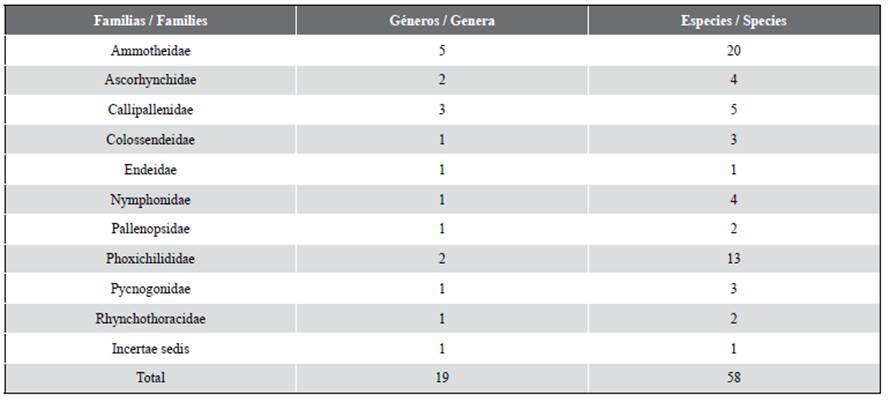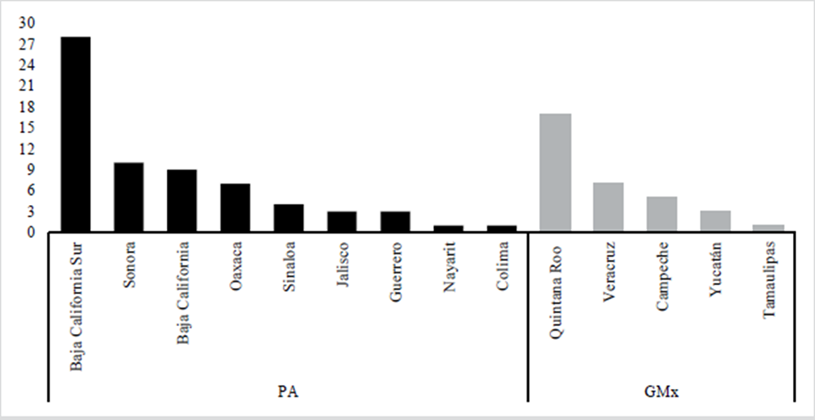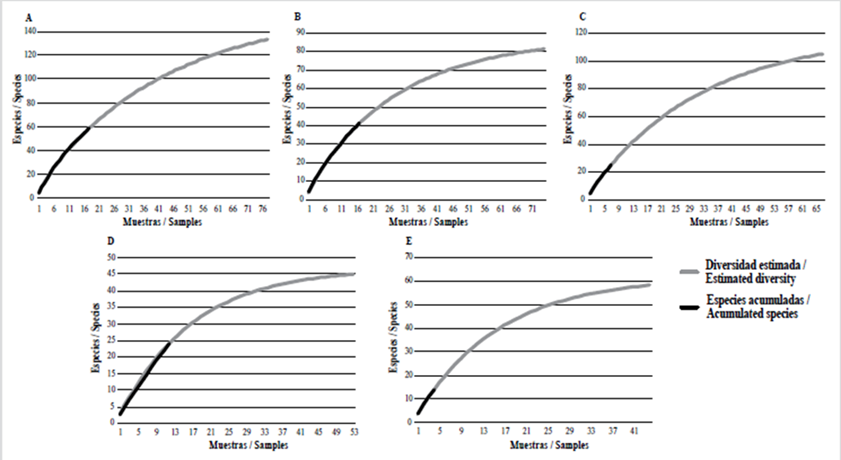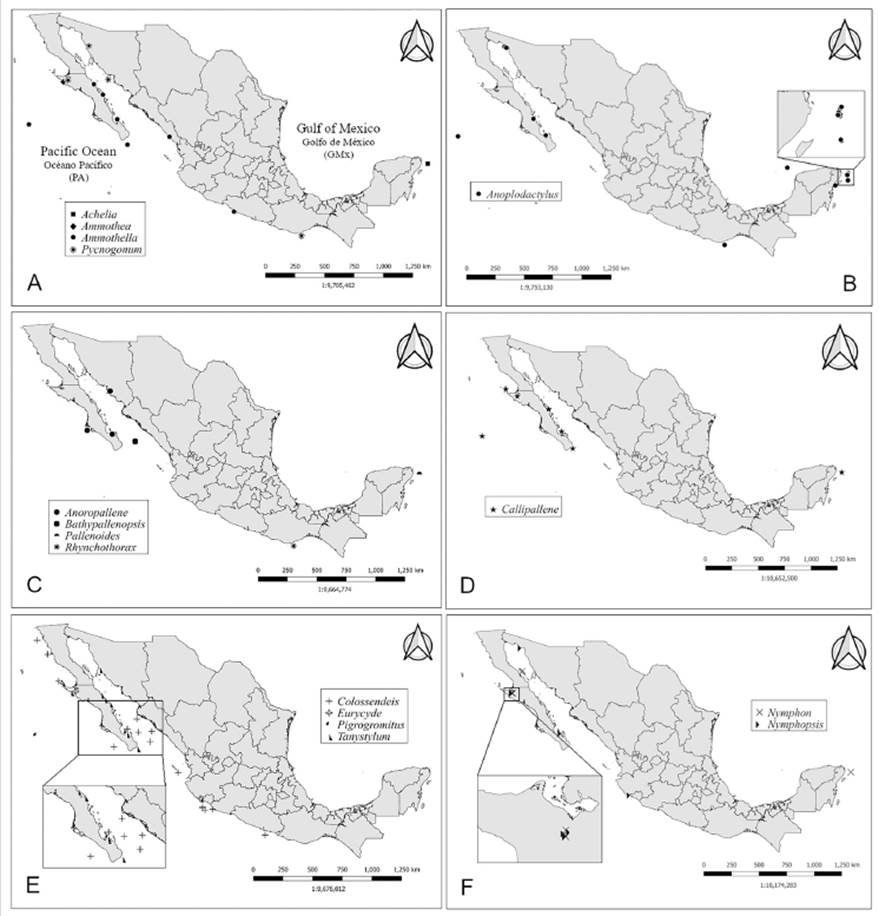INTRODUCTION
Pycnogonids from Mexican waters have been scarcely documented in the literature, with sporadic new records in the Pacific Ocean (PA) and the Gulf of Mexico (GMx). One of the first published records for pycnogonids in the PA of Mexico was that of Schimkewitsch (1893), who recorded three species (De León-Espinosa et al., 2021). During Allan Hancock’s expedition from 1883 to 1887, some pycnogonids were captured but remained unstudied until years later, when Hilton (1942a) analyzed the samples and recorded two species of genus Pycnogonida in the Gulf of California (GC).
Using specimens from the Peabody Museum’s “Albatross collection”, Hedgpeth (1948) published a checklist, which contains 70 species and 24 genera, focused on intertidal and shallow waters of the northern GMx region from the coast of Florida and the Dry Tortugas National Park. He noted that some of these species were located in Mexican waters as well. Other shallow-water studies conducted in coastal Florida, US (Stock, 1955; Child, 1979), produced several additional records that were summarized in a checklist containing 31 species and 14 genera (Child, 1992). Child also indicated that some species within his checklist were found in Mexican waters. Later, Munilla (2002) published an update to the pycnogonids checklist for both PA and GMx waters, recording 42 species, 17 genera, and 6 families in Mexican waters.
Further exploration of the intertidal rocky shores of the coasts of Veracruz confirmed the presence of Achelia sawayai Marcus, 1940 and Anoplodactylus californicus Hall, 1912 (Vasallo et al., 2014), whereas Anoplodactylus batangensis (Helfer, 1938) was discovered in anchialine waters in Yucatán (Alvarez and Ojeda, 2018), and a new record for Baja California Sur (BCS), Eurycyde bamberiDe León-Espinosa and De León-González, 2015, was described. These three states are part of the main ports and touristic regions in Mexico.
In expeditions to the bathypelagic zone, specimens of Colossendeis tenera Hilton, 1943 were found in the PA from GC to waters of Colima state, at depths from 750 to 2.054 m, thus increasing the knowledge about their distribution and ecology (Hendrickx, 2020). Similarly, another expedition through the southern part of the GC and the eastern PA aimed at collecting meso- and bathypelagic arthropod symbionts from depths ranging from 200 to 3600 m. This expedition produced a new record for Bathypallenopsis calcanea (Stephensen, 1933) in Mexican waters (Gasca and William, 2018).
The most recent checklist on Mexican pycnogonids comprises a list of 51 species, with 24 species reported for BCS alone. The authors included the description of two new species for Mexican waters -Tanystylum occidentalis (Cole, 1904) and Nymphon apheles Child, 1979- along with the redescription of seven other species and a possible new record of the genus Tanystylum sp. (De León-Espinosa et al., 2021).
This study aims to update the list of pycnogonids in Mexican waters, in addition to estimating the total potential number of species that could be found in the same region.
MATERIALS AND METHODS
An in-depth research on the literature was conducted to obtain records of pycnogonid species from the PA and GMx waters of Mexico (Schimkewitsch, 1893; Hilton, 1939, 1942a, 1942b, 1942c, 1942d; Hedgepeth, 1948, 1954; Stock, 1955, 1986; Child, 1973, 1979, 1992, 2009; Salazar-Vallejo and Stock, 1987; Müller, 1993; Monteforte and García-Gasca, 1994; Wicksten, 1996; Wright, 1997; Hendrickx and Brusca, 2002; Munilla, 2002; Hendrickx, 2005, 2020; Raiskii and Turpeava, 2006; Foster et al., 2007; Munilla and Soler-Membrives, 2008; Dietz et al., 2013; Corrales-López et al., 2014; Murtaugh and Hernández, 2014; Vasallo et al., 2014; De León-Espinosa and De León-González, 2015; Morales-Zárate et al., 2016; Álvárez and Ojeda, 2018; Gasca and William, 2018; De León-Espinosa et al., 2021). Depth, location, habitat, and geographic distribution were also recorded when available.
The taxonomic validity of the records of the species’ names in this checklist follows the World Register of Marine Species (WoRMS, 2021) and PycnoBase (Bamber, 2021). For geographic references, the nomenclature by Munilla (2002) was adopted.
To improve our understanding of pycnogonids in Mexican waters, and to better estimate the true richness of their species, accumulation curves were calculated with Estimates (Colwell, 2012). To generate the data, a cross match was performed between the times a species was registered at a Mexican state on a single year. Then, a nationwide dataset, oceans datasets (PA and GMx), and a dataset for every Mexican state were created. Rarefaction curves were extrapolated to estimate the expected number of species.
To locate the Mexican Pycnogonida, all specimens with georeferences were mapped using QGIS 3.18.12 ‘Zürich’ and the layer (Shapefile) “División política estatal” (CONABIO, 2008). The map was divided into three portions: one for the NE PA, another for the tropical PA, and the last one for the GMx.
RESULTS AND DISCUSSION
Checklist. A checklist of pycnogonid species reported in Mexican waters is presented in Table 1. For each listed species, details such as general habitat, biology, collection site and coordinates, and distribution are presented. Ten families are reported: Ammotheidae, Ascorhynchidae, Callipallenidae, Colossendeidae, Endeidae, Nymphonidae, Pallenopsidae, Phoxichilidiidae, Pycnogonidae, and Rhynchothoracidae. One species, Pigroromitus timsanus Calman, 1927 was registered as incertae sedis with respect to family placement. Within these families, 19 genera and 58 species are listed, thus increasing the number of species known in Mexican waters by seven. Four of these species were present in both oceans (Anoplodactylus californicus, Pigrogromitus timsanus, Pycnogonum reticulatum Hedgepeth 1948 and Tanystylum duospinumHilton, 1939). In the GMx, 25 species were recorded, while 37 species were reported in the PA. Five holotypes for species described in Mexican waters are listed: (1) Anoplodactylus insignis (Hoek, 1881), Holotype (♂) - University of Miami. Gerda St. 1276; (2) Anoropallene palpida (Hilton, 1939), Holotype (♂) - U.S.N.M. No.79429, Velero III; (3) Ascorhynchus serratusHedgpeth, 1948, Holotype (♀) - U.S.N.M. No.81101; (4) Callipallene californiensis Hall, 1913, Holotype (♂) - N.M.N.H. - Espíritu Santo Island; and (5) Nymphon lituus (Child, 1979), Holotype (♀) - U.S.N.M. No.169205.
Table 1 Reported species of Pycnogonida in Mexican waters, including habitat, biology, location, depth, geographic range, and literature reference. For the geographic references, the abbreviations from Munilla (2002) were adopted: A: Alabama, AA: anfiatlantic, AP: anfipacific, B: Belize, C: California, Ca: Caribbean, Cosmop. Np., Cosmopolitan, not found in polar waters, CR: Costa Rica, EP: East Pacific, F: Florida, GMx: Mexican Gulf, IM: Indo Mozambique, M: Mediterranean, O: Oregon, PA: Pacific, Pc: Pacific Caribbean, Pc+p: Pp. Panamá Pacific, Caribbean Panamá and pacific, PAN: pantropical. T: Texas, t: tropical, WA: occidental atlantic. Cited references: (Alvarez and Ojeda, 20181), (Child, 19792; 19923; 20094), (Corrales-López et al., 20145), (De León-Espinosa and De León-González, 20156; De León-Espinosa et al., 20217), (Dietz et al., 20138), (Foster et al., 20079), (Gasca and William, 201810), (Hedgpeth, 194811;195412), (Hendrickx and Brusca 200213; Hendrickx 200514; 202015), (Hilton, 1942a16;1942b17;1942c18), (Morales-Zarate et al., 201619), (Monteforte and García-Gasca, 199420), (Munilla, 200221; Munilla and Soler-Membrives 200822), (Murtaugh and Hernández, 201423), (Salazar-Vallejo and Stock, 198724), (Schimkewitsch, 189325), (Stock, 195526; 198627), (Vasallo et al., 201428), (Wicksten, 199629), (Wright, 199730).

Out of the 1351 species of pycnogonids described worldwide, 290 species (Bamber et al., 2021) are Ammotheidae, thus making it the most diverse family (Munilla and Soler-Membrives, 2008). This is consistent with our updated checklist, where Ammotheidae is also the most diverse family in Mexican waters, with 20 species in 5 genera. Phoxichilidiidae is the second most diverse family in Mexico, with 2 genera and 13 species, of which the genus Anoplodactylus Wilson, 1878 contains 12 species (Table 2).
The cosmopolitan family Nymphonidae is the second most diverse family worldwide, with 272 species (Munilla and Soler-Membrives, 2008), most of which are placed within the genus Nymphon Fabricius, 1794 (Bamber, 2021). This genus is poorly represented in Mexico, with only four species recorded: Nymphon floridanum (Hedgpeth, 1948) collected in Yucatán, Nymphon lituus in Baja California (Child, 1979) and Guerrero (De León-Espinosa and De León-González, 2015), Nymphon pixellae Scott, 1912 in GC (Hilton, 1942a) and Nymphon apheles Child, 1979 (De León-Espinosa et al., 2021) in BCS.
Due to their holobenthic lifestyle, many pycnogonids were captured in association with other benthic species. For instance Nymphon lituus and Nymphopsis duodorsospinosa Hilton, 1942 were captured from among macroalgal communities of Sargassum C. Agardh, 1820 and Padina Adanson, 1763. Likewise, Anoplodactylus batangensis, A. maritimus Hodgson, 1914, A. pectinusHedgpeth, 1948, A. petiolatus (Krøyer, 1844), A. viridintestinalis (Cole, 1904), Achelia sawayai, Callipallene emaciate (Dohrn, 1881), Endeis spinosa (Montagu, 1808), Nymphopsis spinosissimum (Hall, 1912), Pycnogonum stearnsi Ives, 1883, and Tanystylum geminum Stock, 1954, were found colonizing the marine seagrass Thalassia Banks ex König, 1805, intertidal and green algae communities, kelp, and mangrove roots.
In more complex and probable ectoparasitic or trophic relationships (Dietz et al., 2018), Anoplodactylus insignis, A. viridintestinalis (Cole, 1904), Callipallene californiensis, Eurycyde bamberi, N. lituus, N. duodorsospinosa, Pycnogonum rickettsi Schmitt, 1934, Tanystylum californicumHilton, 1939, and three unidentified species of the genera Ammothella Verrill, 1900, Nymphon, and Tanystylum Miers, 1879 were collected in association with bryozoans, a basket star, hydroids, sponges, as part of the epifauna of oyster pearls Pinctada mazatlanica (Hanley, 1856) and Pteria sterna (Gould, 1851), or as epibionts of the giant lion paw scallop Nodipecten subnodosus (Sowerby I, 1835). Ammothella spinifera Cole, 1904 was found parasitizing the polychaete Bispira melanostigma (Schmarda, 1861), and there was one record of Bathypallenopsis calcanea in a commensal relationship with the medusa Aeginura grimaldii (Maas, 1904). Further details and references on these various associations can be found in Table 1.
Depth varies for most of the reported species, ranging from 0 to 64 m. The deepest record for Mexican waters was Colossendeis tenera, found between 2.038 and 2.054 m in the Northeast PA of Baja California (Hendrickx, 2020). As a result of deep sea exploration in GC waters, B.calcanea was reported in BCS (Gasca, 2018), in addition to the recent record of C. tenera in the same state. The diversity for BCS has increased from 24 (De León-Espinosa et al., 2021) to 26 species, and two unidentified specimens found in the region remain undescribed.
The usual and most successful places for finding pycnogonids are diverse and include coastal shores, bays, lagoons, reefs, coral beaches, and intertidal and fouling waters. Moreover, it has been shown that some pycnogonids can be collected by providing an artificial substrate with oyster baskets, as was the case of T. californicum (Murtaugh and Hernández, 2014). The search for pycnogonids in the deep sea remains largely understudied because of the great challenges it poses. It is technically difficult to reach bathypelagic and abyssal ecosystems such as hydrothermal vents, ridges, and trenches. Even though these challenges exist, deep sea exploration should be encouraged, since there is a great lack of knowledge from these zones (Schnabel et al., 2020). In addition, it is known that pycnogonids can sink to greater depths but have been poorly captured, thus increasing the endemicity reported in the bathyal and abyssal zone (Raiskii, 2006).
Out of the 17 states that comprise the coastline of Mexico, 14 have been explored in the search of pycnogonids. Most of the records are from BCS, Sonora, and QROO waters, whereas the least studied states are Tamaulipas, Nayarit, and Colima (Figure 1). BCS and Sonora waters are part of the GC, and this important ecoregion harbors the highest diversity of studied Pycnogonida in Mexico.
Alas, it also suffers from environmental issues with pollutants such as metals, metalloids, arsenic, selenium, fertilizers, pesticides, livestock rearing effluents, shrimp farms eutrophic components discharge -which contribute to the elongation of hypoxic or anoxic stages and patched ecosystems, both in water and biota- and the presence of harmful algal blooms, all this due to frequent anthropogenic activity (Páez-Osuna et al., 2017). An additional problem for many species of pycnogonids is the persistent oxygen minimum zone (OMZ) in the eastern PA. This wide area off the western coast of Mexico leads to a rapid depletion of the dissolved oxygen as the depth increases, threatening the diversity of organisms found in this bathymetric range (Luch-Cota et al., 2007)
Dubious records. While searching for Mexican pycnogonid records, some inconsistencies in the literature and databases were found, which are described in Table 3. For example, three species present at the National Museum of Natural History (NMNH), Smithsonian Institution Invertebrate Zoology Collection Database (2020), were assigned unpublished taxonomic names, and no additional specimens are available for study.
Table 3 Registered inconsistencies among ten records/captures of pycnogonids in Mexican waters. EP: East Pacific, GMx: Mexican Gulf, NWA: Northwest Atlantic, SWA: Southwest Atlantic. Cited authors references: (Child, 19791; 20092), (Fabrizio et al., 20193), (Hedgpeth, 19484), (Hendrickx, 20205), (Hilton, 19396), (Raiskii, 20067).
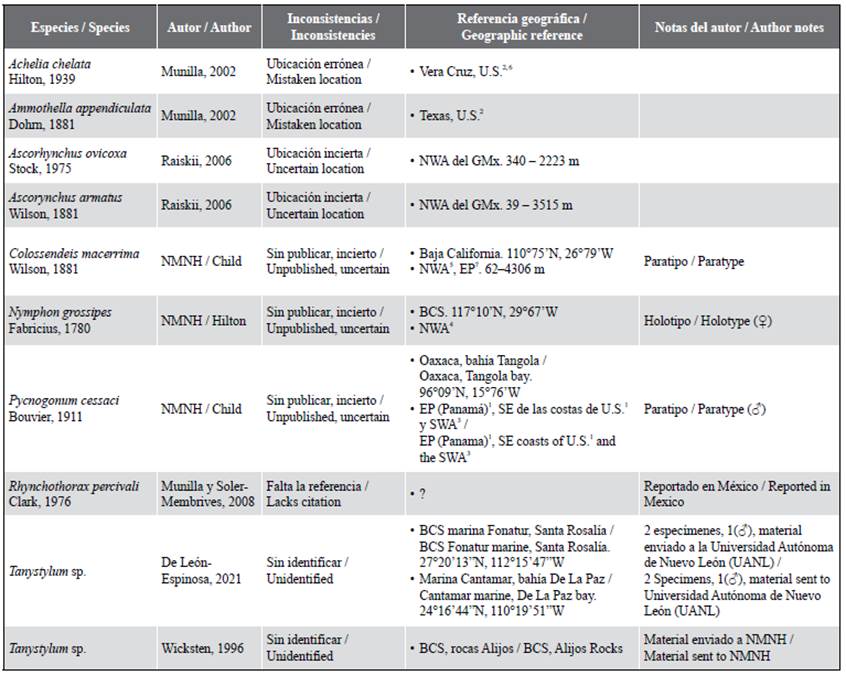
Two of the species reported in literature were inconclusively identified, Tanystylum sp. (Wicksten, 1996) and Tanystylum sp. (De León-Espinosa et al., 2021). The former was suggested as a new record for PA by Child C.A., with taxonomical resemblance to a species from Panama, although complementary data remained unpublished. It was concluded that the latter remained undescribed due to its morphological differences with other Tanystylum species.
According to Munilla’s checklist (2002), Achelia chelata was reported by Hilton in 1939 as a Mexican species in the coastal waters of Veracruz, although that record was from the locality of Vera Cruz in California USA. Therefore, this record does not count as a Mexican record and was not included in this checklist.
Ammothella appendiculata (Dohrn, 1881) was allegedly recorded in QROO waters by Child, 1979 and Hedgpeth, 1948 (Munilla, 2002), but there are no such records in the original papers. The closest record of A. appendiculata was reported in Texas, USA (Child, 2009). Due to the geographic proximity to Tamaulipas, this species may be present in Mexican waters, but, since it is not a confirmed occurrence, it was not included in the checklist. Rhynchothorax percivali Clark, 1976 was previously reported in Mexico (Munilla and Soler-Membrives, 2008), but there was no information on the location nor a clear reference as to where it could be found. However, it was included in our checklist in the hope that future studies shed light on this matter.
The following records also are also questionable. Raiskii and Turpeava (2006) reported the species E. spinosa (3 - 5000 m) and A. maritimus (0 - 4379 m) in the NWA of the GMx. Records for these species were already present, but only in shallow waters. Two more species -Ascorhynchus ovicoxa Stock, 1975 (340 - 2223 m) and A. armatus (Wilson, 1881) (39 - 3515m)- were recorded within the same geographic range; these could be new records for Mexican waters, but, since no precise geographic reference is provided, they were not included in the checklist.
Data Analysis. Most of the datasets for each state were either too small to be computed by Estimates, or the knots distancing requirement for sample extrapolation made the results statistically unsatisfactory in terms of representativeness. Only BCS and QROO, along with each ocean and nationwide datasets, were effectively computed and graphed (Figure 2).
None of the rarefaction curves reached the asymptote, thus indicating that there is a need for further collection to better represent the true diversity. The asymptote in the nationwide rarefaction curve was predicted below 140 species, with the ones collected so far representing about half of that estimate. The asymptote for PA is expected to be at 80 species, which also represents twice the number of currently documented records. In contrast, the asymptote for GMx is projected to be close to 100 species, which is five-fold the present number of documented species. Finally, the asymptotes of BCS and QROO are estimated to be close to 40 and 60 species, respectively; BCS is missing only a third of the species to reach the plateau, and the prediction for QROO species is nearly six times the current species. These estimations indicate that the collection efforts and species occurrence nationwide, per ocean (PA and GMx), and in BCS and QROO are currently insufficient to fully describe the diversity of Mexican pycnogonids. The rarefaction curves also indicate that substantially more fieldwork must be conducted to better estimate the true diversity of pycnogonids in Mexican waters.
The geographic references are more frequently and thoroughly documented in studies covering GC than those performed either in the tropical NE PA or the GMx. This became evident when the georeferenced individuals were mapped with QGIS (Figure 3). There are 13 genera distributed in the GC map, in comparison with the eight genera mapped in the tropical NE PA and the three genera registered in the GMx. The lack of clear geographic references at the capture sites is another area of opportunity to overcome in order to increase the knowledge about the distribution of these species in Mexican waters.
CONCLUSIONS
The number of pycnogonid species recorded in Mexican waters increased from 51 to 58. Some aspects of the basic biology of pycnogonids are known, but much is yet to be discovered. For instance, there are records of their commensalism and parasitic relations with other biological groups, but there is no explanation on how these relations work both in shallow waters and at great depths. This depth range either suggests a great flexibility in their habits or supports the need for more detailed taxonomic studies using molecular characterization.
Because of the spaced collecting efforts and inconsistency in specimen georeferencing, dubious distributional records were identified. If these specimens were carefully reexamined, the number of species for Mexico could increase. Overall, the current described diversity for Mexico represents 4.3 % of the world’s species. Since the projected number of species for the country is 140, this calculation potentially could increase to 10 %.
It is clear that the main economic port regions of Mexico are where most previous collection efforts were focused. This shows the need to explore new areas such as the states of Michoacán, Chiapas, and Tabasco, which currently stand without any record of this group. Alongside these increased efforts, better attention should be paid to labeling specimens, since some geographic references were not clear. Accompanying this data, georeferences could be added in order to project better maps for understanding their ecology and distributional patterns.











 text in
text in 


